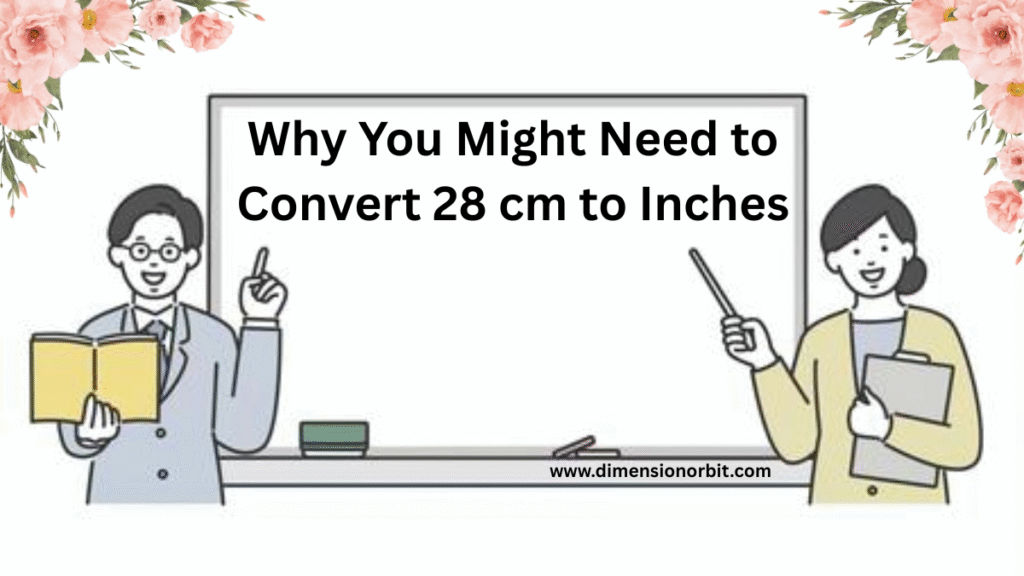Ever tried to picture 28 cm in inches and ended up squinting at a ruler like it’s written in code? You’re not alone. Somewhere between online shopping, IKEA manuals, and measuring that “perfect” shelf space, we’ve all questioned if centimeters were invented just to mess with us. It’s the classic metric versus imperial standoff a global confusion that’s lasted longer than most reality TV shows. But don’t worry, you won’t need a math degree or divine intervention to solve it. In this guide, we’ll turn 28 centimeters to inches into something so simple you’ll actually remember it no calculator induced headaches required.
Why You Might Need to Convert 28 cm to Inches

Imagine you’re buying furniture online from another country, and the product description lists its height as 28 cm. If you’re used to measuring things in inches, you might have no idea how tall that really is. This happens often when dealing with international brands or tools that use different systems. Understanding conversions like this helps you make more accurate decisions and avoid expensive mistakes. The need for such conversions isn’t just limited to shopping. Designers, engineers, and even cooks frequently switch between metric and imperial systems. The more global our world becomes, the more relevant this skill gets.
How Tall Is 66 Inches? 10 Common Things
The Exact Conversion 28 cm Equals 11.02 Inches

The formula to convert centimeters to inches is simple and universal:
Inches = Centimeters × 0.393701
So when you multiply 28 by 0.393701, the result is 11.02 inches. That means anything that measures 28 centimeters is just over 11 inches long. This isn’t an estimate; it’s the precise value based on the international definition of an inch. Knowing this gives you an immediate reference point for daily situations, especially when product dimensions, screen sizes, or clothing measurements are expressed in centimeters.
For a quick mental estimate, you can divide the centimeter value by 2.5. It’s not exact, but it gives a fairly close answer. Using this method, 28 divided by 2.5 equals 11.2 a result that’s very close to the actual conversion.
Pringles Can Dimensions Size,Height & Everything
What Are Centimeters and Inches, Really?

A centimeter is part of the metric system, which is used almost everywhere in the world. It’s based on the meter, the fundamental unit of length in the International System of Units (SI). The system was designed to make conversions easy because it’s based on powers of ten. One hundred centimeters make a meter, and ten millimeters make a centimeter. This logical structure makes the metric system ideal for science, medicine, and global trade.
An inch, on the other hand, belongs to the imperial system, which is used mainly in the United States, the United Kingdom, and Canada. Historically, the inch was defined by the width of a man’s thumb, but that changed as measurement standards evolved. Today, one inch is officially equal to 2.54 centimeters. Unlike the metric system, imperial units don’t align perfectly by factors of ten, which makes them less straightforward but still deeply rooted in culture and tradition.
A Brief Look at History

The story of inches and centimeters goes back centuries. Ancient civilizations measured things using their own body parts or everyday objects, such as the width of a finger or the length of a foot. These local systems worked within small regions but caused confusion across borders. The metric system emerged in France in the late eighteenth century as part of an effort to standardize measurements for trade, science, and education. It quickly spread across Europe and eventually became the global standard.
The inch, however, remained firmly embedded in English-speaking countries. In 1959, a major international agreement standardized the inch as exactly 2.54 centimeters. That definition unified the system and made conversions like 28 cm to inches universally accurate.
Why Conversions Still Matter in 2025

Despite the dominance of the metric system, conversions remain a necessary skill. In 2025, international trade, digital design, and e commerce all rely on precise measurement comparisons. A company in Japan may list a product’s dimensions in centimeters, while its American customer expects them in inches. This overlap means that conversions are not just academic exercises they are vital to communication, design accuracy, and global business operations.
Even in everyday life, the mix of systems persists. Laptop screens, televisions, and mobile devices are still marketed in inches, while technical specifications and global standards often use centimeters. Understanding how to convert between the two makes you more informed and confident when interpreting measurements across regions and industries.
How Big Is 2mm? 11 Real Examples
The Mathematics Behind Conversion

Converting between centimeters and inches is all about applying the right ratio. Since one inch equals 2.54 centimeters, the conversion in either direction uses this relationship as a foundation. To convert centimeters to inches, you multiply by 0.393701. To go from inches to centimeters, you multiply by 2.54.
For instance:
- 28 cm × 0.393701 = 11.02 inches
- 11 inches × 2.54 = 27.94 cm
This reciprocity is what makes conversions consistent. The accuracy of this formula matters in technical work such as engineering or architecture, where even a fraction of an inch can make a difference.
Common Conversion Errors and How to Avoid Them

Many people make simple mistakes when converting measurements, and these errors can lead to costly consequences. One common issue is rounding numbers too early. For example, using 0.4 instead of 0.393701 might seem close enough, but it introduces a small discrepancy that grows when scaled up. Another frequent mistake is confusing centimeters with millimeters. A difference of one decimal point can significantly alter the result. Some also misplace the decimal or confuse inches with feet when switching between systems. Being careful with decimal points and keeping track of units avoids these issues entirely.
What 28 cm Looks Like in Everyday Life

If you’re trying to visualize 28 centimeters, think of something roughly the width of a standard sheet of paper. A typical A4 paper is 29.7 cm tall, so 28 cm is just a little shorter than that. Many tablets and small laptops also measure around 28 cm across, and the average adult forearm is roughly that length as well. When converted, 28 cm equals about 11 inches a length that sits comfortably between a standard letter-sized paper and a tablet device. These comparisons help the measurement make sense beyond the numbers.
The Ongoing Debate Metric vs Imperial

The coexistence of the metric and imperial systems continues to spark debate. The metric system’s precision and simplicity make it ideal for science and international trade. It’s used by almost every country in the world and has clear relationships between units. The imperial system, by contrast, is woven into cultural habits. Americans measure height in feet and inches, drive miles instead of kilometers, and use Fahrenheit for temperature. Switching to metric completely would require massive adjustments across industries and infrastructure.
Even in 2025, these systems live side by side. Companies and individuals must adapt to both, and conversions like 28 cm to inches are part of that reality. Understanding them allows you to move fluidly between worlds that measure differently but communicate the same ideas.
Precision and Practical Application

Precision is more than mathematical correctness; it’s about ensuring compatibility. When designing a product, building furniture, or fitting clothing, small differences can create big problems. For example, if a part is designed in centimeters but manufactured in inches, the final product might not fit. Knowing the exact conversion factor — that 28 cm equals 11.02 inches helps maintain consistency across projects.
In technology, precision drives design decisions. Device screens, for instance, are often listed in inches, but internal components may be measured in millimeters. When engineers translate these dimensions, they rely on the same basic formulas consumers use, only with greater decimal precision.
How to Convert Without Tools

While calculators and apps make conversions instant, understanding the math behind them gives you flexibility. To convert centimeters to inches manually, multiply the centimeter measurement by 0.393701. To make it easier without memorizing decimals, you can remember that four centimeters roughly equal one and a half inches. So, 28 cm is around seven sets of four centimeters, giving about eleven inches close to the exact answer. This estimation method works well when you’re doing quick calculations on the go.
Measurement and Modern Living

The persistence of two measurement systems says something about how humans adapt. In kitchens, recipes from Europe often use grams and centimeters, while American cookbooks rely on cups and inches. The same duality shows up in construction manuals, fashion, and design specifications. Being bilingual in measurement terms able to think in both inches and centimeters is an advantage that smooths communication across borders.
In modern homes, understanding both systems helps with everything from hanging wall art to assembling furniture. A bracket listed as 28 cm wide will require about eleven inches of space. Knowing that in advance saves time and avoids frustration.
Putting It All Together
So what does all this mean in practice? Converting 28 centimeters into inches isn’t just about numbers. It’s about understanding scale and applying it naturally. Once you know that 28 cm equals 11.02 inches, you can visualize how long that is and use it in daily tasks without hesitation. The same logic applies whether you’re converting 10 cm, 50 cm, or any other measurement. The key is mastering the ratio: one inch equals 2.54 centimeters, and one centimeter equals 0.393701 inches.
By seeing the link between these systems, you gain the confidence to navigate both with ease. Whether you’re a student, a designer, or a casual shopper, this skill ensures accuracy and convenience.
Digital tool
Digital tools like Feet and Inches Calculator can convert inches to centimeters or feet instantly. Many smartphone apps now offer augmented reality measuring features, allowing you to gauge objects virtually and compare them to known lengths.
FAQs
How many inches are in 28 cm?
There are exactly 11.02 inches in 28 centimeters. This conversion is based on the formula: Inches = Centimeters × 0.393701.
How can I convert 28 cm to inches without a calculator?
A quick mental trick is to divide the centimeter value by 2.5. So, 28 ÷ 2.5 = 11.2 inches. It’s not perfect, but it’s close enough for everyday use.
Why does the U.S. still use inches instead of centimeters?
The U.S. sticks with the imperial system mainly due to tradition, industry standards, and the high cost of converting infrastructure to the metric system.
Is 28 cm the same as 11 inches?
Almost! 28 cm equals 11.02 inches, so it’s just a tiny bit longer than 11 inches about the width of a thick pencil more.
What does 28 cm look like in real life?
It’s about the width of a standard sheet of paper, the length of a forearm, or roughly the width of a tablet screen.
Can I use 0.4 instead of 0.393701 to convert cm to inches?
You can, but it’s a rough estimate. Multiplying by 0.4 gives 11.2 inches instead of 11.02 close, but slightly off for precise work.
How many feet is 28 cm?
If you convert 28 centimeters to feet, you get 0.92 feet, which is just under one foot.
Why is 1 inch equal to 2.54 centimeters?
In 1959, an international agreement standardized one inch as exactly 2.54 cm, ensuring uniformity across scientific and industrial measurements worldwide.
What industries still use inches in 2025?
Fields like construction, design, screen manufacturing, and fashion still rely on inches for labeling, while scientific and global industries use centimeters.
Is it better to use inches or centimeters?
It depends on your purpose. Centimeters offer precision and are globally standardized, while inches remain practical for everyday use in imperial-based countries.
Conclusion
Converting 28 cm to inches is simple math with far-reaching usefulness. The result 11.02 inches might seem trivial, but it bridges two worlds of measurement that continue to shape how we communicate and build. Understanding how to move between centimeters and inches isn’t just about memorizing formulas; it’s about appreciating precision and context in a world that relies on both systems. Every time you measure, design, or buy something, you participate in that global connection. Knowing how to convert 28 cm into inches means you’ll always have the right perspective, no matter which side of the ruler you’re on.

Jhon AJS, the author of Dimension Orbit, is an experienced blogger fascinated by the mysteries of existence. He explores every type of dimension from scientific to spiritual with clarity and creativity. Jhon’s engaging writing style invites readers to think deeper, question reality, and discover new perspectives on the universe.






